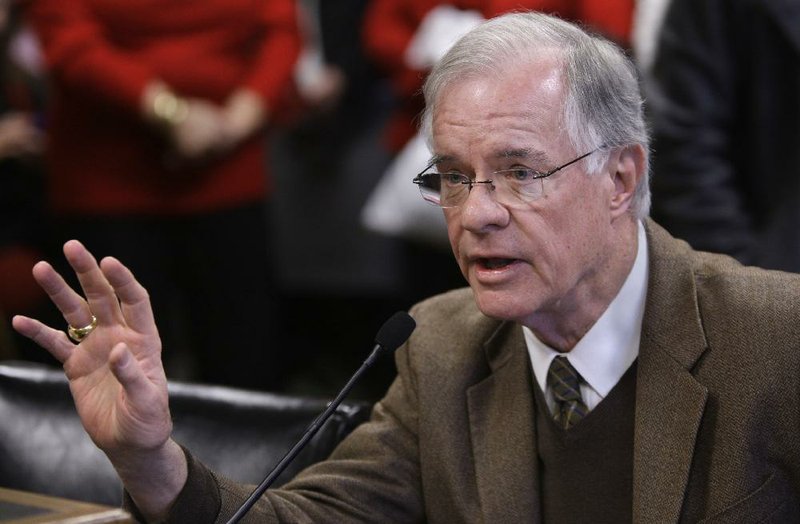More than half of the people enrolled in private, Medicaid-funded plans in Arkansas under the so-called private option are under age 40, and 77 percent are younger than 50, according to information released Wednesday by the state Department of Human Services.
State Medicaid Director Andy Allison said the information shows that the private option “dramatically improves the risk profile” of the population who will be covered by plans on Arkansas’ health-insurance exchange, and could help entice more insurance companies to offer plans on the exchange in future years.
But insurance company representatives said it’s too early to say what effect the enrollment of Medicaid recipients will have on future premiums.
In addition to more than 70,000 Medicaid recipients, those who have enrolled for coverage include more than 12,700 people who do not qualify for Medicaid who had signed up as of Dec. 28.
Max Greenwood, a spokesman for Arkansas Blue Cross and Blue Shield, noted that the medical conditions of those who have enrolled aren’t known.
“I think all we can do is see what kind of experience we get once people are enrolled and utilizing services,” Greenwood said.
Mike Stock, chief executive of QualChoice Health Insurance, gave a similar assessment. Enrollment of younger people through the private option could help, but “what we still don’t know is truly how healthy these people are,” he said.
“You can be sick at any age,” Stock said.
An estimated 250,000 Arkansans became eligible for Medicaid under the expansion of the program approved by the Legislature last year.
The expansion extended eligibility to adults with incomes up to 138 percent of the poverty level - $15,860 for an individual or $32,500 for a family of four.
Most of those who enroll are expected to be able to sign up for private plans on Arkansas’ insurance exchange and have the premium paid by Medicaid, while about 10 percent are expected to be assigned to the traditional Medicaid program because they are considered to have exceptional health needs.
According to figures released by the Human Services Department, 26 percent of those who had enrolled in the private, Medicaid-funded plans as of Jan. 2 were ages 18-29, 30 percent were 30-39, 21 percent were 40-49, 18 percent were 50-59 and 5 percent were 60 or older.
Those who were assigned to the traditional Medicaid program tended to be somewhat older. According to the Human Services Department, 20 percent were ages 18-29, 26 percent were 30-39, 25 percent were 40-49, 24 percent were 50-59 and 6 percent were 60 or older.
Numbers released earlier this week by the U.S. Department of Health and Human Services indicate enrollees who are not eligible for Medicaid were older still.
Those numbers showed that 40 percent of those who had signed up as of Dec. 28 were ages 55-64. Only 18 percent were ages 18-34.
All of those enrolled in a company’s plans on the exchange - regardless of whether the enrollee is eligible for Medicaid - are included in the same risk pool, meaning their medical expenses are used to calculate future premiums. The risk pools also include those who enroll directly with the insurer for unsubsidized coverage outside the exchange.
Older people typically have higher medical costs than younger people, but the health-care law limits how much more insurance companies can charge older people to account for that difference.
For that reason, enrolling a sufficient number of younger people could help keep premiums from rising in future years, health-policy experts have said.
Allison said the addition of Medicaid recipients appeared to reduce the median age of enrollees in plans on Arkansas’ exchange by at least 10 years, to around 40 years old or younger.
He said state officials expected the Medicaid-eligible population to be younger than the general population, but didn’t have detailed information on the demographics of those eligible until after enrollment began Oct. 1.
“We’re exceedingly pleased with the initial age profile that we’ve seen,” Allison said. “It very much reinforces one of the core goals of the private option, which is to strengthen and enhance the marketplace for the state as a whole.”
He added that enrolling those who are not eligible for Medicaid is also important to keep premiums stable. If large numbers of Arkansans remain uninsured, he said, healthcare providers stuck with unpaid bills could increase the rates they charge to insurance companies, which could pass along the increase to consumers through higher premiums.
“Even if the private option substantially protects our marketplace from a premium spiral, we can always do better by enrolling the uninsured,” Allison said.
Greenwood said the Medicaid enrollment doesn’t alleviate her company’s concern that enrollment among those who are not eligible for Medicaid has been lower than expected, and that the average age of enrollees who are not eligible for Medicaid is higher than the company expected.
Stock said low enrollment among those not eligible for Medicaid has raised concerns that the non-Medicaid enrollees will be “high utilizers” of medical care.
“I would say the risk pool looks like it has adverse risk selection,” Stock said. “It’s a risk pool that will generate higher than normally expected claims.”
Under the Patient Protection and Affordable Care Act, people who are not eligible for Medicaid, but have incomes below 400 percent of the poverty level, may qualify for tax credit subsidies to help pay their premiums for plans on the exchange.
The income threshold for those subsidies is $45,960 for an individual or $94,200 for a family of four.
Those who are eligible for Medicaid can enroll in coverage at any time. Others who want to sign up for coverage in 2014 have until March 31.
Insurance Commissioner Jay Bradford said he expects more young people to enroll over the next few months, especially now that a federal enrollment portal, healthcare.gov is working better than it was in October and November.
“The trend is that it’s gaining momentum,” he said.
Front Section, Pages 1 on 01/16/2014

